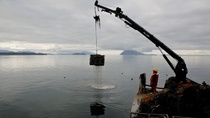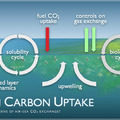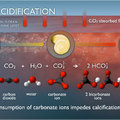
Related Stories
Ocean Carbon Up ...
PMEL scientists are studying how the oceans absorb carbon dio ...
Ocean Acidifica ...
Fundamental changes in seawater chemistry are occurring throu ...
Multi-media
PMEL carbon group frequently works with the media to inform t ...
Acidifying Water Takes Toll On Northwest Shellfish
Puget Sound has some of the world’s most corrosive waters. Scientists are finding that marine waters in the Northwest have become so corrosive that they are eating away at oyster shells before they can form. Below is a video Written, produced and edited by Katie Campbell. Photography by Katie Campbell & Michael Werner. Additional photography by Marc Dewey. Graphics courtesy of NOAA.
Transcript of the video above:
THE OYSTERS GROWN AT SHINA WYSOCKI’S FAMILY FARM NEAR OLYMPIA WASHINGTON ARE SERVED IN SOME OF THE FINEST RESTAURANTS IN MANHATTAN. WHAT’S HER FAMILY’S SECRET TO RAISING THE PERFECT PACIFIC OYSTER?
SHINA: “We think our water tastes great here and that makes our oysters taste great.”
CHELSEA FARMS CAN ONLY RAISE OYSTERS IF THEY CAN PURCHASE OYSTER LARVAE, ALSO CALLED OYSTER SEED, FROM HATCHERIES. BUT OYSTER SEED PRODUCTION IN THE NORTHWEST HAS PLUMMETED IN RECENT YEARS BY AS MUCH AS 80 PERCENT. THE OCEANS ARE BECOMING MORE ACIDIC AS THEY ABSORB CARBON DIOXIDE THAT IS ADDED TO THE AIR FROM BURNING FOSSIL FUELS.
SHINA: “Ocean Acidification is this huge problem and there are so many things -- it’s the currents, it’s the carbon dioxide, it’s the aragonite. Most of which I only understand a tiny fraction of, but what I do understand is when the nursery calls on the phone and says there’s no oyster seed to ship. They had the oyster beds all ready to go, they've spent all this time getting them there and there's nothing to put out - it's sad!"
PUGET SOUND HAS SOME OF THE MOST CORROSIVE WATER FOUND ANYWHERE IN THE WORLD. A NATURAL PROCESS BRINGS INCREASINGLY ACIDIC WATER FROM THE DEEP OCEAN TO THE SURFACE -- WHERE SHELLFISH LIVE. THAT’S WHY WASHINGTON’S SHELLFISH INDUSTRY -- A $270 MILLION DOLLAR A YEAR BUSINESS THAT SUPPORTS 3200 JOBS --- IS THE FIRST TO FEEL THE EFFECTS OF THE GLOBAL PHENOMENON CALLED OCEAN ACIDIFICATION.
BILL DEWEY: “We're an industry that relies on calcifiers, so we’re the first to see the affects and to scream about it.”
WORKERS AT TAYLOR SHELLFISH FARMS FIRST NOTICED A PROBLEM IN THEIR HATCHERIES IN DABOB BAY.
DEWEY: With oysters, the vulnerable stage that dissolves in these corrosive waters in the first two or three days of their life, they’re using a form of calcium carbonate to build their shell that dissolves really easily.
FEELY: When the water was highly corrosive the organisms died within two days – the oyster larvae simply died. When the water was high pH they did just fine. It was just like a switch.
RICHARD FEELY IS ONE OF THE WORLD’S LEADING RESEARCHERS ON ACIDIFICATION. HE HELPED HATCHERIES DEVELOP TACTICS TO PREVENT MASSIVE OYSTER LARVAE DIE-OFFS BY CAREFULLY MONITORING THE PH OF SEAWATER.
DEWEY: It’s been absolutely crucial. Something that simple has recovered maybe 75% of the losses we had in larvae production just by being able to see this water and work around it.
BUT FEELY WARNS THAT THIS IS A SHORT-TERM SOLUTION.
FEELY: “Over the next 20-30 years, these short term adaptation strategies won’t work because as we continue to release more and more CO2 in the atmosphere and that will be taken up by the oceans eventually the oceans will be corrosive 50% of the time or 60% of the time within the next 30-40 years.”
FEELY HAS BEEN TRACKING THE CHANGING OCEAN CHEMISTRY SINCE THE 1980’S. AND HE’S DISCOVERED THAT THE OCEANS ARE ALREADY 30 PERCENT MORE ACIDIC THAN THEY WERE AT THE START OF THE INDUSTRIAL REVOLUTION. RECENT MODELS PROJECT THAT IN THE COMING DECADES PH WILL CONTINUE TO DROP.
FEELY: This would be a 100 to 150% increase of the acidity of the oceans by the end of the century. This is a very dramatic change that has not been seen in the world’s oceans for more than 50 million years.
AND THE CHANGE IS HAPPENING SO QUICKLY THAT SCIENTISTS WORRY MARINE ANIMALS WON’T HAVE TIME TO ADAPT.
PAUL McELHANY: “There’s never been any time in the history of the planet that we know of that CO2 has increased as quickly as it is right now.”
PAUL McELHANY LEADS THE OCEAN ACIDIFICATION LAB AT THE NOAA NORTHWEST FISHERIES SCIENCE CENTER IN SEATTLE.
PAUL: The animals that we’re focusing on are the ones that are economically and ecologically important and that we suspect might have vulnerability to changes in CO2 in the environment.
HE’S TRYING TO UNDERSTAND HOW THE IMPACTS OF ACIDIFICATION WILL RIPPLE THROUGH THE ENTIRE FOOD WEB OF THE OCEAN.
PAUL: The difficulty is if we’re going to do anything about that to change that trajectory we need to do it now. By the time we wait until we actually see those changes in the species abundance it will really be too late to do anything about it.
THAT’S WHY WASHINGTON STATE HAS MADE ADDRESSING OCEAN ACIDIFICATION A TOP PRIORITY. GOVERNOR CHRIS GREGOIRE CONVENED A PANEL OF SCIENTISTS, POLICYMAKERS AND INDUSTRY OFFICIALS TO FIGURE OUT WHAT CAN BE DONE LOCALLY TO ADDRESS THIS GLOBAL PROBLEM. THEY WANT WASHINGTON STATE TO LEAD THE CHARGE. AMONG OTHER THINGS, THEY CALL FOR:
- BEING A LEADER ON REDUCING CARBON EMISSIONS.
- LIMITING LOCAL WATER POLLUTION IF IT’S SHOWN TO EXACERBATE THE PROBLEM.
- AND DEVELOPING LONG-TERM ADAPTATION STRATEGIES FOR SHELLFISH GROWERS
BACK AT THE TAYLOR SHELLFISH, AN ANSWER CAN’T COME SOON ENOUGH. CREWS WORK AROUND THE CLOCK, HARVESTING ABOUT 50,000 OYSTERS PER NIGHT. THESE SHELLFISH WILL END UP ALL OVER THE WORLD.
FEELY: We are the ones who are feeling the effects of this first. We’re the ones where our industries and our people and our livelihoods are being affected first. So we’re leading the way. Protein from the ocean provides food for billions of people on our planet and therefore we need to understand this and appreciate the significance of this. And address it.
NOT JUST FOR LOCAL MARKETS LIKE PIKE PLACE, BUT ALSO TO FEED THE WORLD’S APPETITE FOR PUGET SOUND SEAFOOD. OCEAN ACIDIFICATION THREATENS THEIR BUSINESS, OUR REGION’S REPUTATION FOR SEAFOOD, AND A NORTHWEST WAY OF LIFE.




